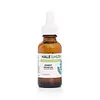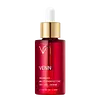What's inside
What's inside
 Key Ingredients
Key Ingredients

 Benefits
Benefits

 Concerns
Concerns

 Ingredients Side-by-side
Ingredients Side-by-side

Caprylic/Capric Triglyceride
MaskingSimmondsia Chinensis Seed Oil
EmollientSimmondsia Chinensis Seed Wax
Skin ConditioningHeptyl Undecylenate
EmollientSqualane
EmollientCitrullus Lanatus Seed Oil
EmollientPlukenetia Volubilis Seed Oil
EmollientLimnanthes Alba Seed Oil
Skin ConditioningHelianthus Annuus Seed Oil
EmollientCalendula Officinalis Flower Extract
MaskingTocopherol
AntioxidantHippophae Rhamnoides Seed Oil
Skin ProtectingBetula Alba Leaf Extract
AstringentSalvia Sclarea Oil
MaskingEucalyptus Globulus Leaf Oil
PerfumingCaprylic/Capric Triglyceride, Simmondsia Chinensis Seed Oil, Simmondsia Chinensis Seed Wax, Heptyl Undecylenate, Squalane, Citrullus Lanatus Seed Oil, Plukenetia Volubilis Seed Oil, Limnanthes Alba Seed Oil, Helianthus Annuus Seed Oil, Calendula Officinalis Flower Extract, Tocopherol, Hippophae Rhamnoides Seed Oil, Betula Alba Leaf Extract, Salvia Sclarea Oil, Eucalyptus Globulus Leaf Oil
Candida Bombicola/Glucose/Methyl Rapeseedate Ferment
AntimicrobialOlea Europaea Fruit Oil
MaskingHelianthus Annuus Seed Oil
EmollientActinidia Chinensis Seed Oil
EmollientSilybum Marianum Ethyl Ester
Skin ConditioningCitrullus Lanatus Seed Oil
EmollientAleurites Moluccanus Seed Oil
Skin ConditioningCaprylic/Capric Triglyceride
MaskingRosa Canina Fruit Oil
EmollientSimmondsia Chinensis Seed Oil
EmollientCorylus Avellana Seed Oil
EmollientPrunus Avium Seed Oil
EmollientLithospermum Erythrorhizon Root Extract
Skin ConditioningPlukenetia Volubilis Seed Oil
EmollientAngelica Gigas Root Extract
Skin ConditioningPrunus Amygdalus Dulcis Oil
Skin ConditioningRosmarinus Officinalis Leaf Oil
MaskingSpilanthes Acmella Flower Extract
Skin ConditioningCitrus Aurantium Bergamia Fruit Oil
MaskingCitrus Aurantium Dulcis Peel Oil
MaskingLavandula Angustifolia Oil
MaskingCedrus Deodara Wood Oil
MaskingThymus Vulgaris Oil
MaskingJuniperus Mexicana Oil
MaskingLeptospermum Petersonii Oil
MaskingLupinus Albus Seed Extract
Skin ConditioningRosa Centifolia Flower Oil
MaskingJasminum Grandiflorum Flower Extract
MaskingDaucus Carota Sativa Seed Oil
EmollientCupressus Sempervirens Oil
MaskingBoswellia Serrata Oil
MaskingCitrus Aurantium Amara Flower Oil
MaskingTocopherol
AntioxidantEucalyptus Globulus Leaf Oil
PerfumingCandida Bombicola/Glucose/Methyl Rapeseedate Ferment, Olea Europaea Fruit Oil, Helianthus Annuus Seed Oil, Actinidia Chinensis Seed Oil, Silybum Marianum Ethyl Ester, Citrullus Lanatus Seed Oil, Aleurites Moluccanus Seed Oil, Caprylic/Capric Triglyceride, Rosa Canina Fruit Oil, Simmondsia Chinensis Seed Oil, Corylus Avellana Seed Oil, Prunus Avium Seed Oil, Lithospermum Erythrorhizon Root Extract, Plukenetia Volubilis Seed Oil, Angelica Gigas Root Extract, Prunus Amygdalus Dulcis Oil, Rosmarinus Officinalis Leaf Oil, Spilanthes Acmella Flower Extract, Citrus Aurantium Bergamia Fruit Oil, Citrus Aurantium Dulcis Peel Oil, Lavandula Angustifolia Oil, Cedrus Deodara Wood Oil, Thymus Vulgaris Oil, Juniperus Mexicana Oil, Leptospermum Petersonii Oil, Lupinus Albus Seed Extract, Rosa Centifolia Flower Oil, Jasminum Grandiflorum Flower Extract, Daucus Carota Sativa Seed Oil, Cupressus Sempervirens Oil, Boswellia Serrata Oil, Citrus Aurantium Amara Flower Oil, Tocopherol, Eucalyptus Globulus Leaf Oil
Ingredients Explained
These ingredients are found in both products.
Ingredients higher up in an ingredient list are typically present in a larger amount.
This ingredient is an emollient, solvent, and texture enhancer. It is considered a skin-softener by helping the skin prevent moisture loss.
It helps thicken a product's formula and makes it easier to spread by dissolving clumping compounds.
Caprylic Triglyceride is made by combining glycerin with coconut oil, forming a clear liquid.
While there is an assumption Caprylic Triglyceride can clog pores due to it being derived from coconut oil, there is no research supporting this.
Learn more about Caprylic/Capric TriglycerideCitrullus Lanatus Seed Oil is made by expressing watermelon seeds. It is a non-fragrant oil with antioxidant and hydrating properties.
Watermelon seed oil contains a high percentage of linoleic acid and other fatty acids. These fatty acids make it a great skin hydrator. This ingredient may not be fungal-acne safe.
This oil is derived from the leaves of Eucalyptus Globulus, a type of Eucalyptus tree native to Australia.
Though this oil shows antibacterial and antioxidant activity, it is also a known skin-irritant due to its fragrance components.
Helianthus Annuus Seed Oil is the oil derived from the seeds of a Sunflower. Sunflower seed oil is non-fragrant. It is an emollient, meaning it helps to soften the skin.
Sunflower seed oil contains many fatty acids. The fatty acids found in sunflower seeds include (from highest amount to least): linoleic acid, myristic acid, palmitic acid, stearic acid, arachidic acid, oleic acid, and linolenic acid.
These fatty acids help the skin create ceramides. Ceramides play a role in repairing the skin barrier.
Helianthus Annuus Seed Oil helps moisturize the skin. This in turn helps the skin look more rejuvenated and smoother.
Sunflowers are rich in vitamin E.
Historians believe Indigenous cultures of North America domesticated sunflowers before corn. Thus they relied on sunflower oil for a variety of uses. One such use is moisturizing skin and hair.
Sunflower seed oil may not be fungal acne safe. We recommend speaking with a professional if you have any concerns.
Learn more about Helianthus Annuus Seed OilPlukenetia Volubilis Seed Oil is an oil and isn't fungal acne safe.
This oil comes from the seeds of the desert shrub called Jojoba. It is more commonly known as jojoba oil, a non-comedogenic oil.
Jojoba oil does not contain fragrance and has many fatty-acids, making it a great soothing ingredient.
It also contains Vitamin E, a great moisturizing ingredient. Vitamin E is also an antioxidant and protects your skin against oxidative damage.
This ingredient humectant properties, meaning it helps draw moisture from the air. This helps keep your skin hydrated.
While jojoba has antibacterial properties, it is only able to kill some strains of bacteria.
Studies also show it helps in wound healing. In fact, Indigenous cultures have used jojoba as a moisturizer and to help treat burns for centuries.
Fun fact: Jojoba oil similar to natural human skin sebum, so it has a great effect on dry skin. It is also promising with helping to regulate sebum production.
Due to its fatty acid content, Jojoba oil may not be fungal acne safe. We recommend speaking with a professional if you have any concerns.
Learn more about Simmondsia Chinensis Seed OilTocopherol (also known as Vitamin E) is a common antioxidant used to help protect the skin from free-radicals and strengthen the skin barrier. It's also fat soluble - this means our skin is great at absorbing it.
Vitamin E also helps keep your natural skin lipids healthy. Your lipid skin barrier naturally consists of lipids, ceramides, and fatty acids. Vitamin E offers extra protection for your skin’s lipid barrier, keeping your skin healthy and nourished.
Another benefit is a bit of UV protection. Vitamin E helps reduce the damage caused by UVB rays. (It should not replace your sunscreen). Combining it with Vitamin C can decrease sunburned cells and hyperpigmentation after UV exposure.
You might have noticed Vitamin E + C often paired together. This is because it is great at stabilizing Vitamin C. Using the two together helps increase the effectiveness of both ingredients.
There are often claims that Vitamin E can reduce/prevent scarring, but these claims haven't been confirmed by scientific research.
Learn more about Tocopherol